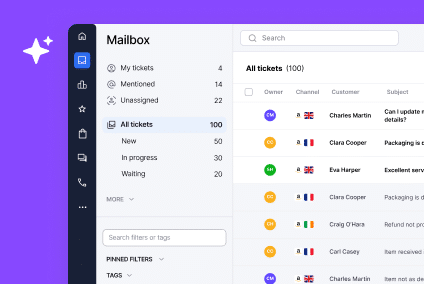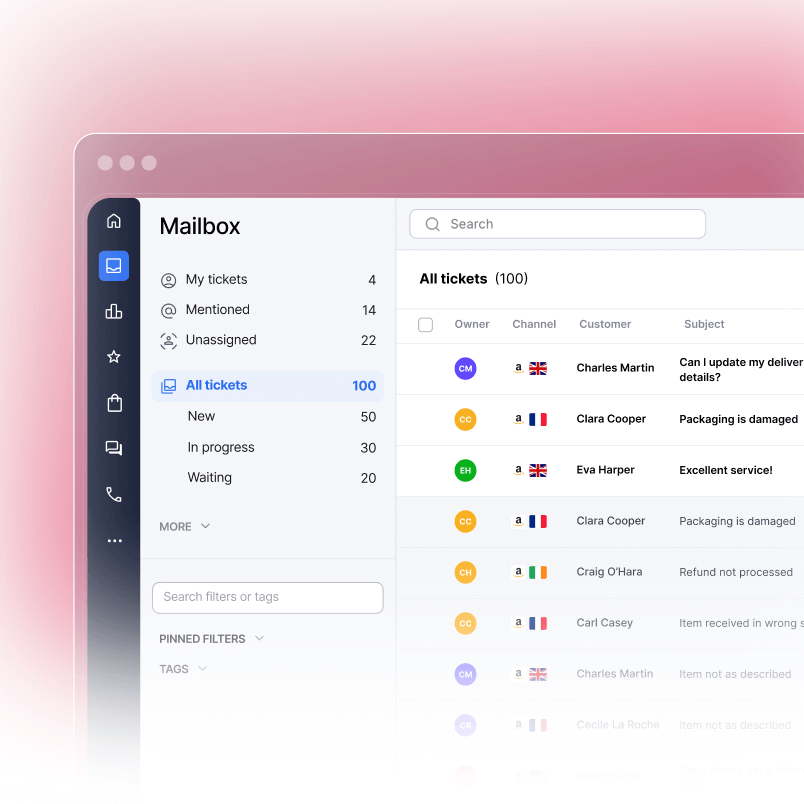When a customer emails your support team at midnight, you’re probably asleep. But an AI system isn’t. It’s reading their message, understanding their problem, and either solving it instantly or routing it to the right person. That’s AI customer service in action.
If you’ve ever gotten an instant response from a company on their website or received a perfectly relevant help article without asking, you’ve experienced it firsthand. Most support teams today are hybrid. They blend AI efficiency with human expertise. The result: faster answers, happier customers, and less burnout for your team.
In this guide, we’ll walk through exactly how AI customer service works. We’ll break down the core technology behind it, show you real tools in action, and help you understand what it means for your support operation.
What Is AI Customer Service?
AI customer service uses machine learning and natural language processing to handle customer interactions without human intervention. It reads customer messages, understands intent, and either resolves issues automatically or passes them to a human agent with relevant context. Think of it as a smart triage system that works around the clock.
The key difference from traditional support: AI operates at scale. A human agent handles one conversation at a time. An AI system handles thousands simultaneously. It learns from every interaction and gets better over time.
How AI Customer Service Differs From Traditional Support
Traditional support is reactive. A customer writes in. They wait for someone to respond. That person reads the ticket, looks up information, and replies.
AI customer service is proactive and instant. The moment a message arrives, the system analyzes it. It categorizes the issue, checks sentiment, and routes it if needed. Many issues resolve without any human involvement.
This doesn’t mean AI replaces humans. It means humans focus on complex problems while AI handles routine ones. A support team member spends their day on issues that need empathy, judgment, and creativity instead of answering “Where’s my order?” for the hundredth time.
Where AI Fits in Your Support Funnel
Picture your support funnel like this. At the top: thousands of incoming messages. At the bottom: resolved issues.
AI sits at every stage. It filters incoming messages at the top, prioritizes them in the middle, and suggests solutions at the bottom. Here’s how it breaks down.
Incoming messages arrive. AI flags urgent issues and deprioritizes low-priority ones.
Simple questions get routed to AI chatbots. These handle FAQs, password resets, and status checks.
Complex issues go to human agents with full context and suggested solutions already prepared.
Follow-up messages get automatic responses while the agent works on the case.
This funnel compresses support time dramatically. Simple questions sink to the bottom while complex issues go to human agents with full context and suggested solutions already prepared.
Core Components of AI Customer Service
AI customer service isn’t one tool. It’s an ecosystem of interconnected systems working together. Here are the main components you need to understand.
Smart Inbox and Ticket Triage
This is where AI starts. Every customer message arrives at your support inbox. Normally, support agents manually sort these by urgency and category. A smart inbox does this automatically.
AI tags each ticket with relevant categories. It detects whether the tone is frustrated, neutral, or happy. It identifies what the customer actually needs. Is this a billing issue? A technical problem? A feature request?
Then it prioritizes. A message from your highest-value customer gets flagged. A frustrated customer moves to the front of the queue. Routine questions sink to the bottom.
This process takes milliseconds. Without it, your fastest agents still spend time deciding what to work on first. AI removes that bottleneck entirely.
AI Chatbots and Virtual Assistants
A chatbot is AI’s first response to most customer interactions. It’s powered by natural language processing, which means it understands human language in context, not just keywords.
Basic chatbots match keywords to responses. “Where’s my order?” triggers a canned answer.
Advanced chatbots understand what you’re really asking. They grasp context and history. They handle follow-up questions without resetting the conversation.
Pre-trained chatbots come out of the box with common responses already built in. Custom-trained chatbots learn from your specific support history and company knowledge. They sound like your brand.
Most chatbots today operate 24/7. When your team sleeps, the chatbot works. It can’t solve every problem, but it handles the bulk of simple requests.
Auto-Responses and Suggested Replies
When a ticket arrives at 2 AM, your customer doesn’t want to wait until 9 AM for a response. An automated acknowledgment goes out immediately: “We got your message. Here’s what we’re doing about it.”
But modern AI goes further. It can generate contextual replies for your team. An agent opens a ticket. The AI suggests three possible responses based on the customer’s issue and tone. The agent picks one, edits it, and sends it. This cuts response time in half for routine issues.
The best systems adapt to tone. If a customer is angry, the suggested reply has a different tone than one for a neutral question.
Knowledge Base Integration
Many customer questions have answers already written somewhere. Your help docs, FAQ page, or internal wiki contains the solution. But the customer doesn’t know where to find it.
AI integrates with your knowledge base. When a customer asks a question, the system searches your docs and surfaces the most relevant article automatically. The customer sees the answer instantly. If they’re talking to a human agent, the agent gets the relevant doc linked right there in the interface.
This serves two purposes: it resolves issues faster, and it trains your AI over time. The system learns which docs actually solve problems.
Conversational AI and Context
This is the most sophisticated layer. Conversational AI remembers everything. It knows the customer’s history, previous issues, purchase records, and past conversations.
A customer might say, “The thing I ordered last month isn’t working.” Conversational AI doesn’t just see “isn’t working.” It knows which product they bought, when, how much they paid, and whether they’ve had issues before.
It handles multiple languages without missing nuance. It maintains context across a long conversation instead of starting fresh with each message.
It integrates with your CRM. All the customer data your team sees is also available to the AI.
Benefits of AI in Customer Service
The practical impact of AI customer service shows up in your metrics almost immediately.
Speed and Scale
Response times drop dramatically. While your team operates within business hours, AI operates all hours. A customer in London gets an instant response at 3 AM their time.
You also handle more volume with the same team size. AI chatbots can manage up to 80% of routine tasks and customer inquiries, depending on your industry. That frees your team to handle the remaining complex issues.
In fact, chatbots are predicted to save businesses up to 2.5 billion hours of work by the end of 2024. This isn’t just time saved. It’s capacity reclaimed.
Cost Reduction
Every support agent costs money. Every hour an agent spends on routine work is an hour they can’t spend on revenue-generating or strategic work. AI reduces both direct and indirect costs.
You need fewer agents to hit the same response time targets. You spend less on training because routine issues don’t require as much training. You reduce burnout because agents work on interesting problems instead of repetitive ones.
Consistency and Tone
Your brand voice matters. A human support agent might have a different tone depending on their mood or workload. AI delivers the same tone every single time. This consistency builds trust.
It also means your brand voice scales. Instead of hiring for cultural fit and training on tone, your AI learns your brand voice and applies it everywhere.
24/7 Availability
Customers expect instant help. They don’t care what time it is. AI makes round-the-clock support feasible without paying agents to work night shifts.
This is especially valuable for SaaS companies, eCommerce brands, and any business with a global customer base. Your support never closes.
Where AI Falls Short and Why Human Handoff Matters
AI is powerful, but it’s not magic. It fails on genuinely complex problems. These are situations that require judgment, empathy, or deep industry knowledge.
A customer is upset because a product didn’t meet their expectations. They need acknowledgment and creative problem-solving. AI can detect frustration and escalate the issue, but a human needs to rebuild that relationship.
A customer has a unique situation that doesn’t fit standard troubleshooting steps. An AI might offer generic advice. A human agent can think outside the box.
A customer needs to discuss pricing, negotiate terms, or make exceptions. These require human authority and judgment.
The best AI systems recognize these limits. They escalate to humans gracefully. The human agent receives the full context so they don’t start from zero. This handoff is seamless. The customer doesn’t repeat themselves.
Maintaining empathy matters. An AI can simulate empathy, but it can’t feel it. Customers sense the difference. The best support teams use AI for triage and efficiency, then let humans handle moments that need genuine human connection.
AI Customer Service Tools in Use
The market is full of AI-powered support platforms. Here are the most popular options and what they do.
| Tool | Key Feature | Best For | Typical Starting Price |
| eDesk | Unified inbox with AI routing and automation | Multi-channel eCommerce support | Custom pricing |
| Intercom | AI chatbots with advanced NLP | SaaS and B2B customer engagement | $39/month |
| Ada | Conversational AI with CRM integration | Enterprise support automation | Custom pricing |
| Zendesk AI | Ticket routing and suggested responses | Businesses of all sizes | $49/month base + AI add-on |
| Freshdesk Freddy | AI ticket assistant with knowledge integration | Growing teams and enterprises | $25-99/month |
| Drift | Conversational AI for sales and support | B2B sales engagement | $500/month+ |
Each tool has different strengths. eDesk focuses on eCommerce workflows. Intercom excels at product messaging. Zendesk is the traditional powerhouse.
The choice depends on your industry, team size, and existing tools. Most integrate with common platforms like Shopify, BigCommerce, and WordPress.
Real-World AI Customer Service Examples
Let’s ground this in reality. Here’s how different businesses use AI customer service.
A direct-to-consumer apparel brand receives 15,000 support tickets per month. Most are order tracking, sizing questions, and return inquiries. They implement an AI chatbot. It handles 60 percent of these questions instantly. Their three-person support team focuses on product feedback and complex returns. Response time drops from 48 hours to 4 hours. Customer satisfaction increases because customers get faster answers and their team actually has time to think about feedback.
A SaaS company has a global customer base across 12 time zones. Their support team works 9-5 in a single time zone. They implement conversational AI with knowledge base integration. Customers in off-hours time zones get instant answers from the AI or a suggested help article. When they do need human support, they join a queue and a human agent picks it up during business hours with full context already loaded. Their “time to first response” improves dramatically. Churn decreases.
An eCommerce company with multiple brand sites uses AI to route tickets to the right support agent or the right brand’s knowledge base. A customer message about an order shows up in the correct queue instantly. Auto-responses go out with tracking information. If a return is needed, the AI initiates it automatically. Agents only step in when judgment is required. Support costs drop 35 percent.
The most striking real-world example comes from Klarna, a financial services company for eCommerce. Within one month of launching their AI assistant, it held 2.3 million customer conversations, representing two-thirds of total interactions. This is equivalent to the work of 700 full-time human agents. The AI achieved similar customer satisfaction scores as Klarna’s human agents and reduced repeat inquiries by 25%. Average resolution time dropped from 11 minutes to just 2 minutes.
Is AI Replacing Your Support Team?
Not exactly. But support roles are changing.
AI handles routine work. This frees your team from repetition. But it doesn’t eliminate the need for human support. Complex issues, angry customers, and creative problem-solving still require humans.
What changes is the mix of work. Support agents spend less time answering FAQs and more time solving hard problems. This is better for them and better for your business. 71% of customer service reps report that AI increases time spent on enjoyable work duties.
How Support Roles Are Evolving
New roles are emerging alongside traditional support agents.
Bot trainers are support specialists who review AI interactions, flag mistakes, and improve the system’s training data. They ensure the bot stays accurate and on-brand.
CX analysts focus on the big picture. They review support metrics, identify trends, and recommend changes to products or processes based on what customers are saying.
Specialist agents handle complex or high-value customer interactions. They work on cases the AI escalates and spend their time on problems that matter most.
Support teams are shrinking in volume but growing in expertise. You need fewer bodies, but those bodies need deeper skills.
Final Insights
AI customer service isn’t a replacement for support teams. It’s a force multiplier. It handles volume, improves speed, and lets your team focus on what matters.
The best implementation starts small. Pick one problem to solve. Maybe it’s reducing response time for order status questions. Maybe it’s triaging tickets faster. Measure the impact. Build from there.
The market opportunity is enormous. The AI customer service market will reach $47.82 billion by 2030, growing at a compound annual rate of 25.8% from 2024 onwards. This reflects not hype but real ROI. Companies see average returns of $3.50 for every $1 invested in AI customer service, with leading organizations achieving up to 8x ROI.
Your customers don’t care whether a human or AI solved their problem. They care about getting help fast, with the right answer, in a tone that matches your brand. AI customer service delivers on all three fronts.
FAQs
What is the difference between AI and automation in customer service?
Automation follows predetermined rules. “If ticket contains ‘refund,’ tag it as billing.” AI learns from data and adapts. “This message has a frustrated tone, mentions a defective product, and this customer has bought from us five times. Route to senior agent immediately and suggest a replacement offer.” Automation handles simple if-then scenarios. AI handles complexity.
Can AI handle complex support queries?
AI can identify complex queries and escalate them. It can surface relevant information, suggest solutions, or prepare context for a human agent. But genuinely complex issues that require judgment, negotiation, or creative thinking still need humans. AI works best as a triage system for these cases.
How do I integrate AI into my support stack?
Most AI customer service tools integrate with existing platforms. If you use Zendesk, Freshdesk, or Intercom, you can add AI features directly. If you use eDesk or a custom stack, integration is usually straightforward via API. Start by auditing your current workflow and identifying the bottleneck. Is it volume? Response time? Ticket routing? Choose an AI tool that solves that specific problem. Test with a small portion of traffic first.
What’s the ROI of AI-powered support?
This varies widely. A typical benchmark: AI reduces response time by 40 to 50 percent, handles 40 to 60 percent of routine tickets without human involvement, and reduces support costs by 20 to 30 percent. These savings come from fewer tickets requiring human attention and less training needed for routine work. Start with a baseline of your current metrics. Run a pilot. Track changes in response time, resolution rate, and cost per ticket after three months.




